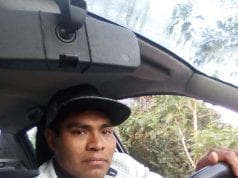
 The commander of the International Space Station has confirmed that a leak in its space capsule was caused deliberately and could have had “severe” consequences for him and his crew. The leak was detected by NASA officials in late August, when flight controllers on Earth noticed a dip in the air pressure of the ISS. It was identified by the crew as coming from a two millimetre hole on a section of the Russian-made Soyuz space capsule. Nasa said at the time the crew were “never in any danger”, but photographs of the hole released later showed what appeared to be drill marks around it, sparking speculation about who carried out what appeared to be a deliberate attempt at sabotage. Alexander Gerst, the German-born commander of the mission, has now scotched suggestions aired in sections of the Russian media that the hole was the work of US astronauts on a previous mission. Instead Gerst appeared to suggest it was the fault of a botched repair job subsequently covered up by construction or maintenance crews on the ground. Alexander Gerst is helped out of the Soyuz MS-09 spacecraft just minutes after landing in Zhezkazgan, Kazakhstan Credit: Getty Speaking on BBC Radio 4’s Today programme on Tuesday he said: “It was pretty clear in my opinion [it was] not the crew that sprung the leak. That was just a few misunderstandings they had out there. “It’s still pretty obvious that it was a man made hole. The hole was there and it was just covered by a little glue, so the question is how did it get there?” The two millimetre hole on a section of the Russian-made Soyuz space capsule Credit: Nasa NASA control only informed the crew about the leak once they woke the following morning, reassuring them there was plenty of air left in their reserve t ank to last for several days. But Gerst said the situation might have been much more serious had the air leakage begun when the Soyuz was taking the crew up to the ISS. “As an astronaut you think ‘Well, what would have happened if it broke loose a little bit earlier, when we were travelling to the space station, when you only have a very small volume of air in that spacecraft?’,” he said. “Even though the hole was small in that case it would have been more more severe for us.” The ISS is manned by astronauts from the United States, Russia, Japan, Canada and Europe and is described “the greatest international project of all time”. Russian spacewalker Oleg Kononenko (suit with red stripes) attached to the Strela boom outside the International Space Station about 250 miles above Earth to inspect the Soyuz MS-09 spacecraft on December 11 Gerst, who returned to earth last month after six months on the ISS, said his view from space had given him and his colleagues a vital perspective on the urgent need to work for the preservation of earth’s natural resources and its threatened environment. “There’s many important things when you fly to space, but perhaps the most important thing – looking down our planet – is to get a perspective of our home,” he said. “If you look from the outside on that planet you realise there’s a whole lot of black around it and that planet does not look sturdy. In fact the ecosystem, that atmosphere, it’s clear that its very fragile and we could destroy the conditions that allow us humans to live comfortably and that is something we often forget.” Gerst, 42, who is also an expert on the power generated by volcanic eruptions, added: “We grow up on the surface of this planet and if we look up the atmosphere just seems so infinite; everything appears to be without end and we think there’s oil and water and everything we need without end. “But if we see it from the outside we realise how there’s really not much there, and that’s it and if we use up these resources then we don’t have a Planet B. That’s the view that every astronaut realises and it’s in our nature to try and bring that perspective home.”
The commander of the International Space Station has confirmed that a leak in its space capsule was caused deliberately and could have had “severe” consequences for him and his crew. The leak was detected by NASA officials in late August, when flight controllers on Earth noticed a dip in the air pressure of the ISS. It was identified by the crew as coming from a two millimetre hole on a section of the Russian-made Soyuz space capsule. Nasa said at the time the crew were “never in any danger”, but photographs of the hole released later showed what appeared to be drill marks around it, sparking speculation about who carried out what appeared to be a deliberate attempt at sabotage. Alexander Gerst, the German-born commander of the mission, has now scotched suggestions aired in sections of the Russian media that the hole was the work of US astronauts on a previous mission. Instead Gerst appeared to suggest it was the fault of a botched repair job subsequently covered up by construction or maintenance crews on the ground. Alexander Gerst is helped out of the Soyuz MS-09 spacecraft just minutes after landing in Zhezkazgan, Kazakhstan Credit: Getty Speaking on BBC Radio 4’s Today programme on Tuesday he said: “It was pretty clear in my opinion [it was] not the crew that sprung the leak. That was just a few misunderstandings they had out there. “It’s still pretty obvious that it was a man made hole. The hole was there and it was just covered by a little glue, so the question is how did it get there?” The two millimetre hole on a section of the Russian-made Soyuz space capsule Credit: Nasa NASA control only informed the crew about the leak once they woke the following morning, reassuring them there was plenty of air left in their reserve t ank to last for several days. But Gerst said the situation might have been much more serious had the air leakage begun when the Soyuz was taking the crew up to the ISS. “As an astronaut you think ‘Well, what would have happened if it broke loose a little bit earlier, when we were travelling to the space station, when you only have a very small volume of air in that spacecraft?’,” he said. “Even though the hole was small in that case it would have been more more severe for us.” The ISS is manned by astronauts from the United States, Russia, Japan, Canada and Europe and is described “the greatest international project of all time”. Russian spacewalker Oleg Kononenko (suit with red stripes) attached to the Strela boom outside the International Space Station about 250 miles above Earth to inspect the Soyuz MS-09 spacecraft on December 11 Gerst, who returned to earth last month after six months on the ISS, said his view from space had given him and his colleagues a vital perspective on the urgent need to work for the preservation of earth’s natural resources and its threatened environment. “There’s many important things when you fly to space, but perhaps the most important thing – looking down our planet – is to get a perspective of our home,” he said. “If you look from the outside on that planet you realise there’s a whole lot of black around it and that planet does not look sturdy. In fact the ecosystem, that atmosphere, it’s clear that its very fragile and we could destroy the conditions that allow us humans to live comfortably and that is something we often forget.” Gerst, 42, who is also an expert on the power generated by volcanic eruptions, added: “We grow up on the surface of this planet and if we look up the atmosphere just seems so infinite; everything appears to be without end and we think there’s oil and water and everything we need without end. “But if we see it from the outside we realise how there’s really not much there, and that’s it and if we use up these resources then we don’t have a Planet B. That’s the view that every astronaut realises and it’s in our nature to try and bring that perspective home.”








